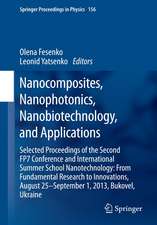Interfacial Compatibility in Microelectronics: Moving Away from the Trial and Error Approach: Microsystems
Autor Tomi Laurila, Vesa Vuorinen, Mervi Paulasto-Kröckel, Markus Turunen, Toni T. Mattila, Jorma Kivilahtien Limba Engleză Paperback – 22 feb 2014
In this revised method four fundamental disciplines are combined: i) thermodynamics of materials ii) reaction kinetics iii) theory of microstructures and iv) stress and strain analysis. The advantages of the method are illustrated in Interfacial Compatibility in Microelectronics which includes:
solutions to several common reliability issues in microsystem technology,
methods to understand and predict failure mechanisms at interfaces between dissimilar materials and
an approach to DFR based on deep understanding in materials science, rather than on the use of mechanistic tools, such as FMEA.
Interfacial Compatibility in Microelectronics provides a clear and methodical resource for graduates and postgraduates alike.
| Toate formatele și edițiile | Preț | Express |
|---|---|---|
| Paperback (1) | 941.05 lei 6-8 săpt. | |
| SPRINGER LONDON – 22 feb 2014 | 941.05 lei 6-8 săpt. | |
| Hardback (1) | 945.79 lei 6-8 săpt. | |
| SPRINGER LONDON – 13 ian 2012 | 945.79 lei 6-8 săpt. |
Din seria Microsystems
- 15%
 Preț: 640.55 lei
Preț: 640.55 lei - 5%
 Preț: 1105.04 lei
Preț: 1105.04 lei - 15%
 Preț: 643.34 lei
Preț: 643.34 lei - 15%
 Preț: 639.73 lei
Preț: 639.73 lei - 18%
 Preț: 952.72 lei
Preț: 952.72 lei - 18%
 Preț: 950.03 lei
Preț: 950.03 lei - 18%
 Preț: 951.29 lei
Preț: 951.29 lei - 5%
 Preț: 1111.09 lei
Preț: 1111.09 lei -
 Preț: 430.69 lei
Preț: 430.69 lei - 20%
 Preț: 1000.38 lei
Preț: 1000.38 lei - 15%
 Preț: 640.06 lei
Preț: 640.06 lei - 18%
 Preț: 952.72 lei
Preț: 952.72 lei - 15%
 Preț: 638.76 lei
Preț: 638.76 lei - 15%
 Preț: 640.71 lei
Preț: 640.71 lei - 15%
 Preț: 638.57 lei
Preț: 638.57 lei - 15%
 Preț: 640.37 lei
Preț: 640.37 lei - 15%
 Preț: 638.43 lei
Preț: 638.43 lei - 15%
 Preț: 643.34 lei
Preț: 643.34 lei - 18%
 Preț: 954.77 lei
Preț: 954.77 lei
Preț: 941.05 lei
Preț vechi: 1147.63 lei
-18% Nou
Puncte Express: 1412
Preț estimativ în valută:
180.08€ • 192.56$ • 150.14£
180.08€ • 192.56$ • 150.14£
Carte tipărită la comandă
Livrare economică 18 aprilie-02 mai
Preluare comenzi: 021 569.72.76
Specificații
ISBN-13: 9781447160687
ISBN-10: 1447160681
Pagini: 228
Ilustrații: X, 218 p.
Dimensiuni: 155 x 235 x 12 mm
Greutate: 0.32 kg
Ediția:2012
Editura: SPRINGER LONDON
Colecția Springer
Seria Microsystems
Locul publicării:London, United Kingdom
ISBN-10: 1447160681
Pagini: 228
Ilustrații: X, 218 p.
Dimensiuni: 155 x 235 x 12 mm
Greutate: 0.32 kg
Ediția:2012
Editura: SPRINGER LONDON
Colecția Springer
Seria Microsystems
Locul publicării:London, United Kingdom
Public țintă
ResearchCuprins
Introduction: Away from trial and error methods.- Materials and interfaces in Microsystems.- Introduction to mechanics of materials.- Introduction to thermodynamic-kinetic method.- Interfacial adhesion in polymer systems.- Evolution of different types of interfacial structures.
Textul de pe ultima copertă
Interfaces between dissimilar materials are met everywhere in microelectronics and microsystems. In order to ensure faultless operation of these highly sophisticated structures, it is mandatory to have fundamental understanding of materials and their interactions in the system. In this difficult task, the “traditional” method of trial and error is not feasible anymore; it takes too much time and repeated efforts. In Interfacial Compatibility in Microelectronics, an alternative approach is introduced.
In this revised method four fundamental disciplines are combined: i) thermodynamics of materials ii) reaction kinetics iii) theory of microstructures and iv) stress and strain analysis. The advantages of the method are illustrated in Interfacial Compatibility in Microelectronics which includes:
•solutions to several common reliability issues in microsystem technology,
•methods to understand and predict failure mechanisms at interfaces between dissimilar materials and
•an approach to DFR based on deep understanding in materials science, rather than on the use of mechanistic tools, such as FMEA.
Interfacial Compatibility in Microelectronics provides a clear and methodical resource for graduates and postgraduates alike.
In this revised method four fundamental disciplines are combined: i) thermodynamics of materials ii) reaction kinetics iii) theory of microstructures and iv) stress and strain analysis. The advantages of the method are illustrated in Interfacial Compatibility in Microelectronics which includes:
•solutions to several common reliability issues in microsystem technology,
•methods to understand and predict failure mechanisms at interfaces between dissimilar materials and
•an approach to DFR based on deep understanding in materials science, rather than on the use of mechanistic tools, such as FMEA.
Interfacial Compatibility in Microelectronics provides a clear and methodical resource for graduates and postgraduates alike.
Caracteristici
Provides solutions to several common reliability issues in microsystem packaging Teaches the reader methods to understand and predict failure mechanisms at interfaces between dissimilar materials Combines thermodynamic-diffusion kinetic modelling with experimental microstructural analysis Includes supplementary material: sn.pub/extras






















